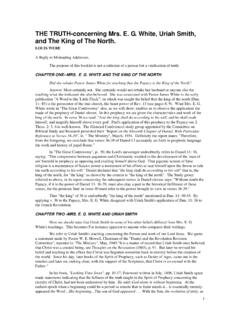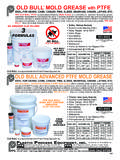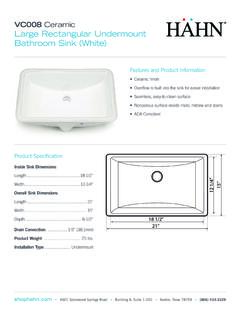Transcription of www.cstsales
1 It s Easy!Order all yoursupplies for thisproject on-line orat Tech - Fri7:30am-4pm a Fiberglass MoldStep 1 Step 2 Step 3 Continue to Step molds are commonly used to make multiple copies of a part which may have a complex shape. Some of the advantages of using a fiberglass mold are: they are easy to make, the materials are inexpensive, they will last for many years and can be used to produce hundreds of parts. The process starts with a pattern that you wish to copy. In this case I have started with a vacuum formed cowl from a model kit. This is a common part that any modeler may want to copy in fiberglass.
2 The pattern could also be shaped from balsa or foam and finished to achieve a glossy parting board is simple, a few scraps of balsa wood glued together to form a U shaped partition that fits over the cowl. In order to achieve a smooth glossy surface on the mold , a piece of .014 Mylar is contact cemented to the balsa scraps. Similarly the mold surface along the back edge of the cowl is defined with a scrap of foam and a sheet of Mylar. The cowl pattern and the parting surface forms are held in place with Chavant modeling clay on the back of each you must decide how many parts you will need to divide the mold into, in order to easily lay up the parts.
3 In order to remove the rigid parts from the mold , you must have a positive relief angle on all the mold parts. This means that the mold cross section must get wider as you go from the deepest part of the mold to the outer edges. For these reasons and because this pattern has a seam horizontally dividing the cowl, I decided to make a two part mold dividing the mold along the pattern seam. The parting surface of the mold defines how the multiple parts of the mold will fit together. This surface is created by building up a parting board that divides the cowl shape in the edges of the cowl pattern the small openings must be sealed.
4 This can be done with modeling clay by pressing clay into the corners and openings then trimming away the excess material with a model knife or razor blade. In this case, the light weight plastic pattern can be distorted if you press to hard. So be careful that the intended shape is a Fiberglass mold , 5 Step 4 Step 6 Step 7 Now you are ready to start applying the layers of epoxy and glass cloth. Use the following West System materials: 105 Resin is a low viscosity resin that easily wets out the cloth and allows you to minimize air bubbles between cloth Fast Hardener allows you sufficient time to wet out each layer.
5 Then gels up quickly so that the mold building process can be completed in a few Colloidal Silica Filler is used to thicken the epoxy system to aid in applying epoxy to vertical surfaces and filling corners and details in the Graphite Powder is used to give the tooling gel coat layer of the mold a black color and a harder black color is important when wetting out glass against the mold surface because air bubbles and dry places in the glass are white while the properly wet out glass is transparent showing the black surface. The high contrast makes it easier to produce high quality parts.
6 Mix tooling gel coat from West System 105 Resin with 205 Hardener and about a teaspoon of Graphite Powder. Then stir in a little Colloidal Silica to get a mixture that has the viscosity of ketchup. You need to be able to brush on a thin layer, (.010" to ,020") and have a mixture that will stay on the vertical surfaces. Begin by brushing a thin layer in all of the corners. Be careful to not trap any air in the corners as you apply this layer, this is a common problem particularly if you mix the gel coat to apply the gel coat layer over the remainder of the surface.
7 Next mix a little more Colloidal Silica into the resin in the pot to increase the viscosity. Apply some additional gel coat to the corners of the mold to fill in any small radii corners. It is difficult to wet out the glass cloth and keep it in corners of less than 1/4" radius. By filling the corners now you are making the glass application all the excess clay is removed, the surfaces of the pattern and parting surfaces must have mold release applied. It is important to a apply both Partall mold release wax and a liquid mold release. The Partall wax is applied by wiping on a layer waiting a few minutes for the wax to harden then buffing off the surface to a shine.
8 The waxing is then repeated; the number of times will depend on the surface. If you have a glossy completely smooth surface like the Mylar plastic, two or three coats of wax will be enough. However if the surface has any potential for porosity or tiny bubbles in the surface finish, up to ten coats of wax are needed. These layers of wax will fill the tiny surface imperfections. If you have any doubt about the surface, add a couple more layers of wax. The epoxy will lock into these imperfections if you don't use enough wax. Then apply a complete layer of liquid mold releases.
9 I recommend the Safelease products as they can be wiped on with a cloth and dry in about 30 to Step a Fiberglass mold , 9 Step 8 Step 10 Step 11 Step 12 Let the gel coat layer of epoxy set up for about 30 minutes. The epoxy should have set to the point where the surface is only a little tacky. Now mix up another batch of West System Epoxy 105/205 and brush a liberal layer on top of the gel coat layer and begin laying strips of glass on the surface. Whenever possible, apply the epoxy first then lay the dry cloth down. This wets out the glass from the bottom displacing the air in the fabric with less chance of trapping air under the layer of wetting out strips of fabric until you have at least two layers of cloth over the entire let this layer set up for about 30 minutes just as you did the gel coat layer.
10 The curing time between layers is not critical. It must be long enough for the epoxy to gel and be only slightly tacky as a minimum and short enough that the epoxy is not nearly cured. So something between 30 minutes and 4 hours will work for a 70 degree shop the mold will need to be strong and rigid, we need to build up the thickness of the mold . An easy way to do this is to add a layer of Coremat. It is about 1/10 inch thick and can be easily cut to any shape. Cover most of the area with Coremat or a thin chopped strand mat could also be used.







